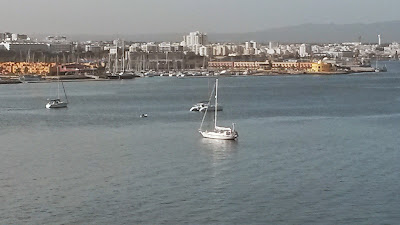Some hard decisions had to be made. We had left England later than originally planned, and it has taken three weeks longer than expected to work our way down the west coast of Europe. Now the wind has gone. There is little or none in the Med, and little or none in the Atlantic. Malta is now out of reach this year, but the fickle winds won’t take us to Madeira either!
Morocco was the only choice – if only to wait for the wind to return.
A big toothless grin greeted our arrival. Ahmed, my guide from my last visit to Smir, helped us secure our lines, and I was only too happy to barter with him for a day out in the mountains to see the souk and the old towns high in the Atlas mountains. But first the formalities…
Gone are the delays and long waits. Gone are the bribes and sweeteners of a few years ago. Entry into Morocco is simple. The friendly marina staff do most of the work, but the Police stamp your passports, both in, and out, of the country.



The drive into the mountains was fascinating. Soaring 2500m, they are covered in patchy course vegetation and small trees. Olive groves abound. Cattle, sheep, and goats, are frequently seen searching out a tender morsel. In this harsh environment the only form of transport for many of the local farmers is the mule, or donkey, and it’s not uncommon to see them in the fields, or on the road, a slow plodding train heading for market. Most wear traditional colourful dress, and some, especially the women, also wear the conical straw hats adorned with tufts of coloured fur.

We visited two cities, Chefchaouen – the blue city – with its Casbah – it’s old medieval town with its winding narrow lanes snaking around the hilltop, the houses steps, even the paths painted in a variety of shades of blue. Many of the old buildings have been modernised, many sprout satellite dishes from their flat roofs. Most have electricity, and water, but the communal taps are still in use – there’s no tax to use them, or the mountain streams, so the women can still be seen scrubbing carpets, and treading the washing, then hanging it on the rocks to dry.



Arriving in Tetuoun, the white city, Ahmed asked if we would like lunch. Western food, or traditional local fare? The chance to try a shish kebab and couscous was a winner. Fully replete, it was off to the souk. Amongst its whitewashed walls you can buy anything. Carpets of course, even a remote control for a twenty year old TV, and computers from a bygone age. New plastic bowls and clay tagines, new clothes, old clothes and shoes –new and second-hand spill from the stalls, or laid out on the dusty road. Then there are the herbs and spices, wonderful breads, vegetables, meat, and fish. The smell of the souk is unforgettable.
All was fresh, the fish not long caught. The chicken was certainly fresh – still running around. The blood and trimmings from the butchered meat and fish was then washed down with buckets of water and run down the central gutter of the narrow street….I rolled my trousers up!

Sailing back to Gib was an experience! The forecast light easterly blew 18-20kts. The wind against tide lifted short steep waves to 3+metres, and the thick fog hid all from sight – as we crossed on of the busiest shipping lanes in the world!
At last the wind returns – we hope – so tomorrow we sail out into the Atlantic, destination Porto Santo 30M north of Madeira.

.jpg)
.jpg)
.jpg)
.jpg)











.jpg)
.jpg)
.jpg)
.jpg)
.jpg)
.jpg)
.jpg)
.jpg)
.jpg)
.jpg)
.jpg)
.jpg)
.jpg)
.jpg)
.jpg)















.jpg)
.JPG)


